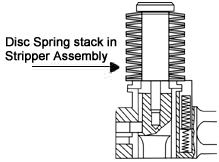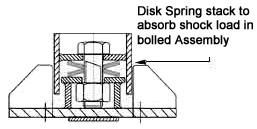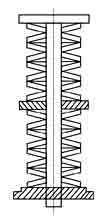|
|
DISC
SPRING INSTALLATION, SETTING & STACKING
Installation:
| a) |
Dynamic
applications, involving large numbers of deflection
cycles, will require that in addition to hardened
seating faces the guide surfaces must also be sufficiently
hard to prevent excessive wear or "stepping".
For both support washers and guide elements, a polished
surface with hardness of 58HRC is sufficient, and
case depth should be 0.60mm min.
|
| b) |
A
most important aid to efficient and extended life
of Disc Spring is the provision of some form of
lubrication. For relatively low-duty Disc
Spring application, a liberal application of suitable
solid lubricant, (e .g. molybdenum-disulphide, grease),
to the contact points and locating surfaces of the
spring is adequate.
|
|
 |
For more severe applications of a dynamic or highly corrosive
nature, the Disc Springs will benefits from maintained lubrication,
and are often housed in a oil or grease filled chamber.
............................................................................................................................................
|
|

|
Disc
Spring with Contract Flats and Reduced Thickness:
For
Disc Springs with a thickness of more than 6mm, DIN 2093
specifies small contact surfaces at point I III in Addition
to the rounded corners. These contact flats improve
definition of the point of load application and reduce
friction at the guide rod. Contact flat increase
spring load which is to be compensated by a reduction
in the thickness from 't' to 't'.
|
|
............................................................................................................................................
Stacking
:
|
|
Series
Stacking: The cumulative effect of bearing point friction
of large numbers of Disc Springs stacked in series, can
result in the Disc Springs at each end of the stack deflecting
more than those in the center. In extreme cases this may
result in over-compression and premature failure of the
end springs. A “rule of thumb” is that the length of the
stacked Disc Springs should not exceed a length approximately
equal to 3 times the outside diameter of the Disc Spring.
|
| Stack
Length : |

|
|
When
stacking Disc Springs, effort should be made to keep the
stacks as short as possible. Friction and other
influences make a stack more uneven. It deflects
more on the side of the loading. This effect usually
can be neglected for a "normal" spring stack,
but not for long stacks. If it is longer, the stack
can be stabilized by dividing it with guide washers, which
as a rule of thumb should have a thickness of at least
one and a half times the guide diameter.
|
|
Address : Plot
No. A-26, Road No. 10, Wagle Industrial Estate, Thane - 400604,
Maharashtra, INDIA
* Tel. : 2582 1941 / 2508 / 2581 3416 * Fax : 91-22-2582
4478
* Email : sales@internationalsprings.com
|
|